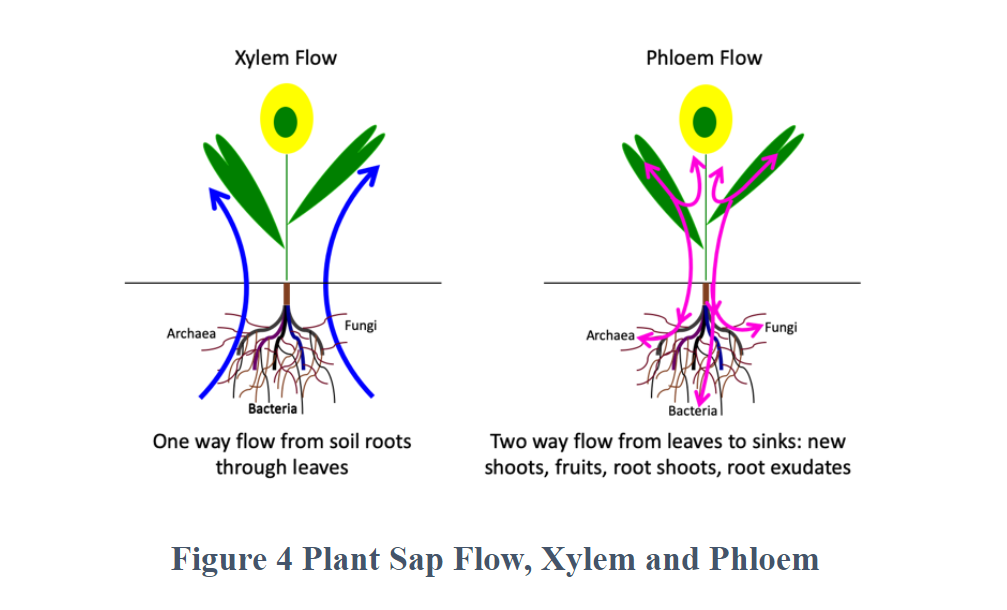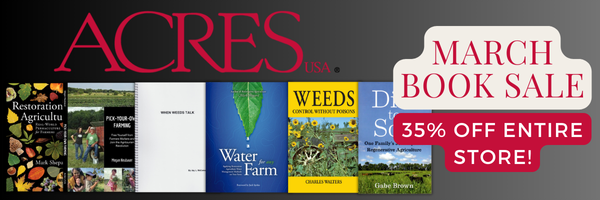A short-term mineralization strategy
I have had a vegetable garden for my entire adult life. Having my hands and bare feet in the soil, soaking up the sun, always made me feel good.
In the beginning, my gardening model was simple: plants grew out of the dirt. Till in cow manure, drop seeds in the ground, water, weed and wait for food to happen (see Figure 1). This model works. Everyone knows that the tomato grown in the garden tastes much better than the one bought in a store.
As I grew older, finding healthy food became more difficult, and my passion for growing became a health choice as well. The need to improve the soil in order to improve the quality and nutrient content of the food we were growing became clear. I needed a new understanding of the interactions between plants and the soil they grow in — a new plant-soil model. It would be many years before the benefits of foliar feeding would become apparent.

My new plant model would need to include minerals, an entire ecosystem of biology, housing and food to support this ecosystem, and a soil structure that allows the exchange of air and the holding of water and minerals (see Figure 2). Finding this information proved difficult at first, but with perseverance and serendipity, sources began to emerge.
At last count there were 18 soil minerals that plants need to thrive. It is not a coincidence that people need all of these minerals as well. Some need to be in large amounts, trace minerals in very small amounts, and all in the correct forms (see Table 1). Some of these were not garden minerals previously thought of — boron, selenium, manganese, molybdenum or cobalt, for instance. My head exploded when I tried to figure out how I was going to distribute 0.5 parts per million of anything over my growing space. And how was I going to mix all these minerals in the right proportions? And what about toxicity? And where does one find molybdenum — never mind pronounce it? Learning seemed to be creating new problems.

The soil biology is the plant’s digestive system, converting soil minerals into forms that plants can use. The parallels to our own gut biome are difficult to ignore. Soil organic matter offers housing for the biology to hide and thrive, and structure for water storage and air circulation, and it acts as a battery, storing minerals in forms that plants can access throughout the growing season. Plants selectively feed this digestive system up to 80 percent of the sugars manufactured during photosynthesis to facilitate the extraction and delivery of needed minerals (see Figure 3).
My soil-plant model was getting more complex and interrelated. These symbiotic relationships are required to grow healthy, nutrient-rich food. Plants grown in a thriving soil ecosystem have improved health. Leaf surfaces form lipid layers, giving that thick, shiny appearance and an increased resistance to airborne pathogens. Sap sugar content increases, as does resistance to insect pressure. These healthy plants produce antioxidants and other phytonutrients — compounds we need for our health. It became clear that the healthcare program I was looking for relied on minerals being in the soil, with a thriving soil biology to digest them into forms plants can access and make into compounds that I could then eat.
With these new ideas in mind, my garden soil was ready for evaluation. Its poor condition was overwhelming. Soil test results revealed significant mineral deficiencies. Soil tilth, organic matter and soil biological diversity were all in need of improvement. Cover crops, mulching and adding rock dusts, compost and local biology would improve the soil, but it takes years to significantly improve these conditions. There was solace in recognizing that the tomatoes I grew tasted better than store-bought, but I needed an effective, short-term strategy for improving the health of the plants grown in my garden as these longer-term strategies were incorporated.
My first attempt at making homemade mineral amendments involved putting weeds into a bucket with rainwater. After a couple of weeks, the contents smelled amazingly terrible, but the plants didn’t seem to mind, and this seemed to be a move in the right direction: no cost, no packaging, no transportation and sustainable. But I needed a better recipe.

The intuitive notion that the best thing to feed a plant is the fruit of that plant offered some insight. If tomato fruits that were not harvested fell to the ground with seeds intact, the minerals and other compounds in the fruit could feed the next generation of tomatoes during germination and beyond. Why not gather ripe, slightly damaged tomatoes and ferment them to make a mineral amendment to feed next year’s tomatoes, as described by Master Cho in Korean Natural Farming? After making many fermented plant juices and analyzing the results, I found all 18 of those needed minerals to be present in specific proportions and forms that plants could use directly (see Table 2).
Using the weak acids in apple cider vinegar to extract minerals from discarded eggshells, oyster shell, shrimp shells or bones from local restaurants is free and closes waste gaps. It is also easy to make your own vinegar; it’s just wine gone bad. Analysis of these products also revealed all of the 18 minerals present, some with high concentrations of calcium and phosphorus (see Table 3).
Vinegar extractions and fermented plant juices are water soluble, shelf stable, sustainable and easy to make, and they often close waste gaps. Used in very low concentrations (1:500), a little goes a long way. This solved two problems: first, where to source the 18 minerals sustainably, and second, how to mix and distribute them safely in the correct proportions. Simply dilute in water and apply.
Incorporating sap flows into my plant model introduced two distinct ways to feed plants and the soil ecosystem. The xylem and phloem flows each draw nutrients from different sources, and move them to, different parts of the plant. Traditional watering through irrigation systems or a watering can wets the soil and feeds plants through the xylem pathway, moving water and nutrients from the soil into the roots and up to the leaves. Much of this water seeps through the soil and past the plant root zone. While soil water content is important for many reasons this may not be the most efficient way to feed plants the nutrients they need.
The phloem sap pathway, by contrast, starts in the leaves and moves sap and the nutrients created during photosynthesis to those places where nutrition is needed for growth: the new shoots at the top of the plant, fruits and seeds, and and root tips that extend into the soil to gather nutrition and send to send out root exudates into the soil — nutrients released from the plant roots to selectively feed the soil biology. By spraying a fine mist of nutrients directly onto plant leaves, all of these most important growth areas of the plant, as well as the soil biology, will be fed through the phloem sap pathway.

This is foliar feeding. Nutrients are absorbed and distributed by the plant in minutes or hours, so plant nutrition problems can be addressed quickly when identified. Using the homemade mineral amendments described above eliminates the guess work of sourcing and mixing proportions to meet plant needs, as all 18 of the needed minerals are present in plant proportions. I was knocked over with the simplicity and efficiency of these ideas — the empowerment of knowing how to improve plant health sustainably and quickly, while simultaneously feeding the soil biology.
Plant mineral needs change during the growing season. Just like humans, the nutritional needs during reproduction are different than those during the teenage years of building stalks and leaves in order to expand photosynthetic capability. Reviewing the analysis results of many homemade amendments and comparing them to plant mineral needs during phases of development reveals an opportunity to positively influence plant growth throughout the growing season.
Germination is the most critical phase of development for any life form. Just like humans, adequate nutrition received during the beginning of life defines many aspects of a plant’s health, including production yields. When making soil blocks for tomato seedlings, why guess what the mineral needs of a germinating tomato might be? Simply mix in a tomato-fermented plant juice so that all of the nutrients the seedling needs are available throughout the soil block, as would happen in nature. As soon as leaves are able to photosynthesize, foliar sprays may be applied to facilitate plant growth and development.
During flowering, the need for phosphorous increases for many plant types. Analysis of vinegar-extracted cow bones shows very high levels of phosphorous, as well as all of those other 18 needed minerals (see Table 3). Flowering may be facilitated by foliar feeding with this homemade mineral amendment. I have coaxed cucumbers to flower the next day after foliar spraying with cow bone vinegar extractions.
During fruiting, the need for calcium increases for many plant types. Analysis of vinegar-extracted oyster shells and eggshells shows very high levels of calcium, as well as all of those other 18 needed minerals (see Table 3). Fruiting may be facilitated by foliar feeding with a vinegar extraction of oyster shell or eggshell homemade mineral amendments, or drenching with these amendments to address tomato black end rot, for example.

For vegetative crops like lettuce, kale and spinach, a limiting factor of plant health is the plant’s ability to photosynthesize. The minerals magnesium, iron, manganese, phosphorous and nitrogen are needed to maximize photosynthetic efficiency. A walk in the local woods once revealed to me sassafras trees with glossy thick leaves, indicative of fine health, although very low in a relatively dense canopy of hardwoods. Using nature as a guide, the thought that sassafras must have high photosynthetic efficiency in order to thrive in the shadow of these relative giants came to light. I made a fermented plant juice from her leaves, and when analyzed, it was found to have high amounts of these important minerals (see Table 2). This is now my foliar amendment of choice to improve photosynthetic efficiency.
Using the characteristics of plants to stimulate phases of plant development is a fascinating idea. What about the early, quick growth of skunk cabbage to stimulate spring plantings, for instance? These are the thoughts of an experimental gardener.
For perennials, as soon as leaves are present in the spring, apply fermented plant juices of that tree’s fruit as a foliar spray to provide nutrients to the new shoots on top, reproductive system, new root tips and roots, which feed the soil biology under the trees. The principles for flowering and fruiting apply here as well. After fruiting, and but before leaves fall off the tree in the fall, apply foliar sprays to provide nutrients that will move to the roots and be available the following spring.
A regular foliar feeding schedule — say, once per week — will significantly improve nutrient availability and the health of plants, depending on the degree of mineral deficiency or excess, biological activity and other environmental stresses endured by the plants. Improved plant health will be visibly apparent. In all cases, if the specific plant amendment is not available, use a broad-spectrum mineral amendment like fermented plant juice of stinging nettle or dandelion.
Learning new concepts and incorporating them into practice is always a challenge. Having both long- and short-term strategies gives an opportunity to sort through the new toolbox of ideas and to identify small steps that will help now, as well as annual steps; together, they move the grower toward sustainable regeneration of soils and growing nutrient-rich foods. Making homemade mineral amendments and using them to feed plants and the soil ecosystem are great short-term strategies to incorporate this year.
I have established a database of homemade mineral amendment analysis results for all to access for free at nigel-palmer.com/data.
Nigel Palmer has graduate and undergraduate degrees in engineering and worked as an aerospace engineer for 367 years. He is the author of The Regenerative Grower’s Guide to Garden Amendments.

















